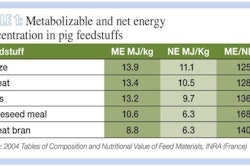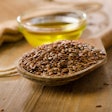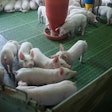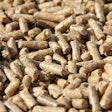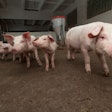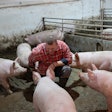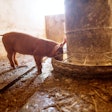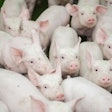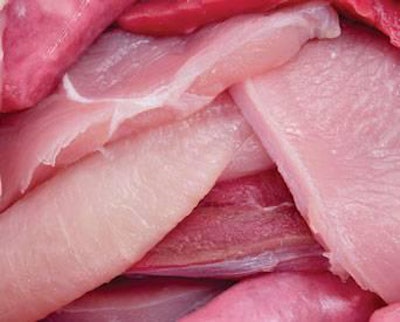
Lipid oxidation is a commonly occurring process which causes meat to deteriorate and change color. The process starts immediately after slaughter when blood circulation stops and anaerobic metabolism starts.
Lipid oxidation is often catalyzed by the presence of free radicals. Hydroxide and nitrogen dioxide are among the most abundant free radicals and are often referred to as Reactive Oxygen Species (ROS) or Reactive Nitrogen Species (RNS). When the concentration of these reactive species exceeds a certain threshold, it becomes harmful to macromolecules such as lipids, proteins and DNA.
However, free radicals are not the only factors which promote lipid oxidization – others include the presence of metals and compounds such as iron, copper, myoglobin and hemoglobin. Crucially, the products of oxidation catalyze further oxidations, resulting in a chain reaction. Once this cyclical process starts, the reaction rate rapidly increases.
Unsaturated fats – in particular those with a large number of double bonds – are extremely prone to oxidation. Preparation processes such as mincing, which destroys cell membranes and increases the surface exposed to oxygen, also increases the risk of oxidation. The addition of sodium chloride during preparation can also be detrimental.
Multiple deteriorating effects
Lipid oxidation impairs meat quality in a number of ways. For example, it degrades polyunsaturated fatty acids (PUFAs) to volatile short-chain compounds such as aldehydes, ketones, alcohols, esters and acids. These compounds cause undesirable odors and flavors, which strongly reduce the appeal of products to consumers.
Another common issue is cholesterol oxidation. Cholesterol Oxidation Products (COPs) are detected at trace levels in raw meat while in storage. During cooking and irradiation these levels increase as more free radicals are generated due to the oxidation of PUFAs. These COPs can cause adverse biological effects such as atherosclerosis, cytotoxicity, mutagenesis and carcinogenesis.
Drip loss occurs at the onset of rigor mortis, when myofibrils shorten and promote exudative loss from meat. Oxidative processes can affect the ability of the membranes to function as a semi-permeable barrier, potentially contributing to fluid leakage. For example, in fresh pork drip, loss tends to increase during refrigerated storage and may cause product weight losses of 8 to 12 percent.
Color is the main factor affecting meat appearance at the time of purchase – and again, lipid oxidation can have a significant negative impact in this area. Color quality is dependent upon the chemical state of the muscle pigment, myoglobin. This pigment will either exist in ferrous oxygenated form, oxymyoglobin (which produces a cherry-red color), or in a ferric oxidized metmyoglobin form (brownish-red in color). During storage and retail display, oxymyoglobin is oxidized to metmyoglobin, with the meat turning an undesirable brown color
Vitamin E: chemistry and metabolism
All living organisms have developed specific mechanisms which protect against reactive species, described by the general term, antioxidant system. Antioxidants, defined as “any substance that delays, prevents or removes oxidative damage to a target molecule” are divided into two key characteristic categories: enzymes and non-enzymatic.
A non-enzymatic antioxidant, vitamin E is a generic term used to describe eight lipid-soluble compounds found in nature. α-tocopherol is the most common and biologically most active form of these compounds. Vitamin E is supplemented in the animal’s diet as the ester of all-rac α-tocopherol (all-rac α-tocopheryl acetate). Studies conducted on the role and requirements of vitamin E are typically performed with commercially available all-rac α-tocopheryl acetate.
The process of vitamin E metabolism can be broken down into a series of key stages:
- Vitamin E is absorbed by epithelial cells in the small intestine, where it is incorporated into chylomicrons.
- It is then transported via the intestinal lymph to the liver.
- From the liver cells, it is secreted by an α-tocopherol transfer protein into general circulation.
- Finally, it is deposited into the membranes and sub-cellular structures, where it exerts its protective effects against phospholipids peroxidation.
The location of vitamin E in the membrane allows it to function very efficiently in protecting highly oxidizable PUFAs from peroxidation by reactive oxygen species. Although found at a lower concentration than phospholipids in the membrane, it is particularly efficient as it can be converted back into the active form following oxidation, by reacting with other antioxidants like vitamin C and carotenoids.
However, for optimum efficacy in preventing lipid oxidation, vitamin E needs to be supplemented in feed at higher levels than usually provided. Excessive vitamin E not used for metabolic purposes will be deposited in cellular membranes.
The proven effectiveness of vitamin E
The mode of action and efficacy of vitamin E in reducing lipid oxidization has been demonstrated in several research papers. Studies have also demonstrated that vitamin E improves membrane fluidity and reduces drip loss.
In a recent trial carried out on broilers, vitamin E supplementation was found to reduce the development of thiobarbituric acid reactive substances (TBARS) – a byproduct of lipid peroxidation – by between 84 and 88 percent when supplemented at levels of 200mg per kg of feed. The production of oxidized cholesterol compounds in chicken meat was also found to lower by 50 percent. In addition, higher levels of vitamin E can reduce the concentration of secondary oxidation products, such as aldehydes and ketones, by around 50 percent.
The same levels of improvement have been found in the oxidative stability of pork. A positive vitamin E antioxidant effect has been observed when supplemented at 200mg per kg of feed in pig rations fortified with 3 percent soy oil and tallow. A 2001 review additionally found a consistent improvement of pork meat oxidative stability when pigs received 100 to 200mg per kg feed of vitamin E.
A 2011 analysis of 13 studies which assessed the effects of vitamin E supplementation found the rate of accumulation to be slower in cattle than pork. Swine tissue saturation in α-tocopherol was reached when feeding 200 to 500 mg/kg of diet. Beef muscle α-tocopherol concentration could be increased from 1.4 to 3.3 μg/g of meat by feeding at least 1,300mg/d of vitamin E for 44 days.
Evidence from meta-analysis studies
Strong confirmation of the positive effect of dietary vitamin E levels on lipid oxidation has been provided by a meta-analysis. The study’s authors analyzed 10 published experiments where lipid oxidation was measured and 13 where vitamin E accumulation was evaluated, in both cases using M. longissimus dorsi muscle.
The meta-analysis established a quantitative relationship between dietary vitamin E and its effects on pork meat quality. A maximum accumulation in muscle tissue was achieved at ca. 6.4mg α-tocopherol per gram of tissue. The meta-analysis also indicated that lipid oxidation gradually increased over three to four days storage post-slaughter and then stabilized up to 10 days post-slaughter.
Improved color stability and reduced drip loss in swine
Another meta-analysis on the effects of dietary vitamin E and storage conditions on pork color stability has found a linear relationship between redness and α-tocopherol concentration. An increase of 1mg of α-tocopherol in the muscle was found to lead to an expected value increase of 0.11 in redness across all storage times. Overall, the meta-analysis suggested that vitamin E supplementation affected redness of pork, but only when supplementation exceeds 100mg per kg of feed and after six days post-slaughter.
The authors of another meta-analysis have recommended that, to achieve optimal water-holding capacity improvement, pigs should be fed 200mg of vitamin E per kilogram of feed for 84 to 130 days before slaughter. Much higher levels (750 to 1.000mg/kg feed) could be fed for a minimum of 45 days in order to achieve a minimum threshold concentration of 2.6mg α-tocopherol per gram of meat tissue.
A unique antioxidant
The susceptibility of meat to lipid oxidation is influenced by the α-tocopherol content of meat and PUFA content of the membrane phospholipids. The beneficial effects of vitamin E on enhancing poultry, pork and cattle meat quality are scientifically proven and commercially tested, validated and implemented.
As nature’s most effective lipid-soluble, chain-breaking antioxidant, vitamin E’s unique function of protecting cellular membrane integrity is hard to substitute with other antioxidants or substances possessing antioxidant-like properties.
References available upon request.




